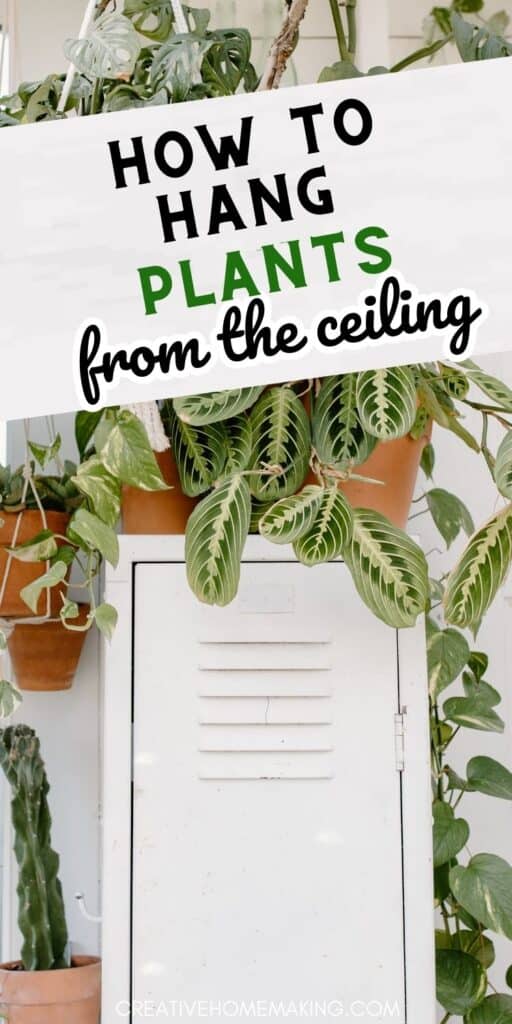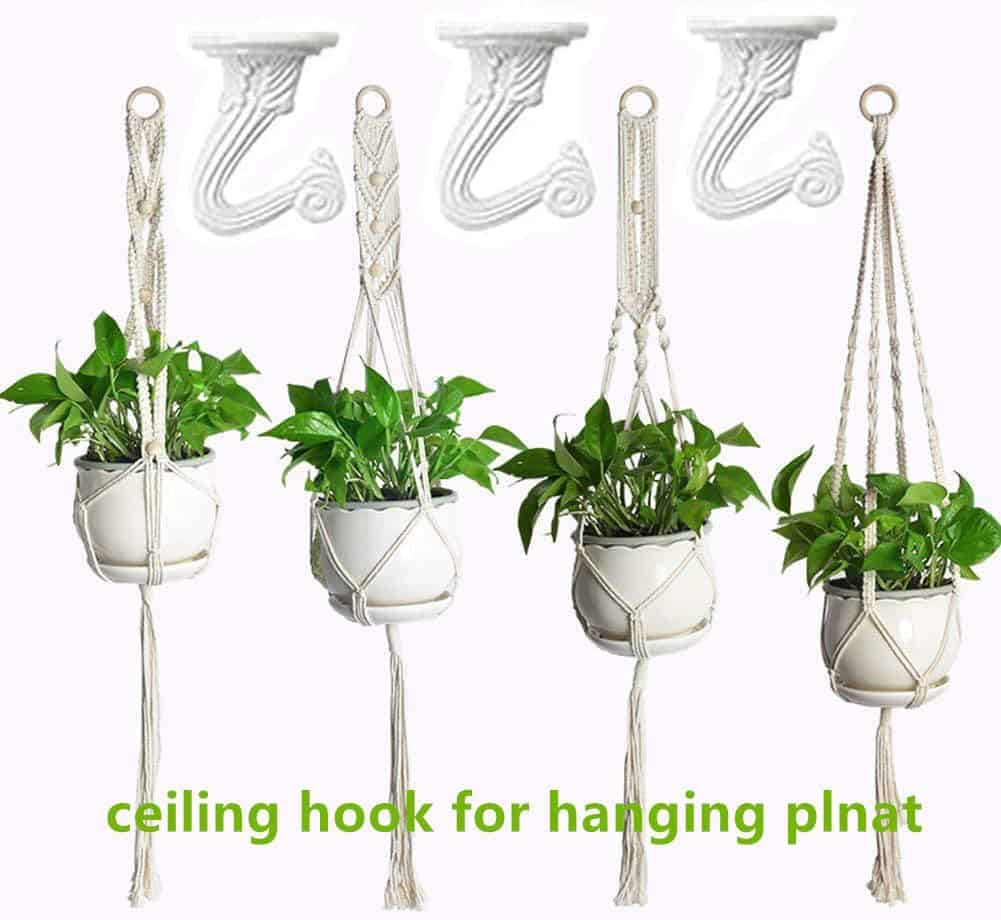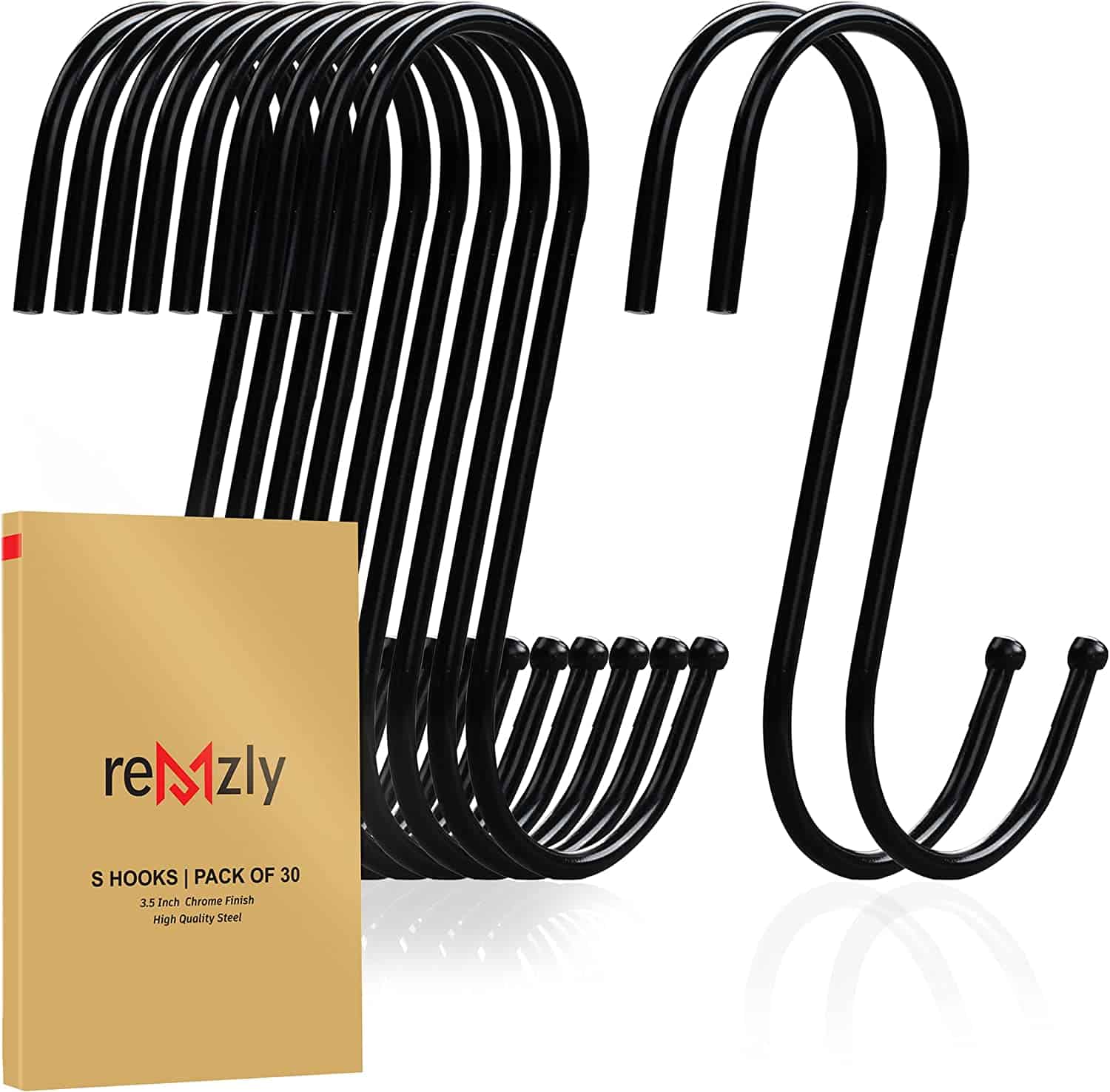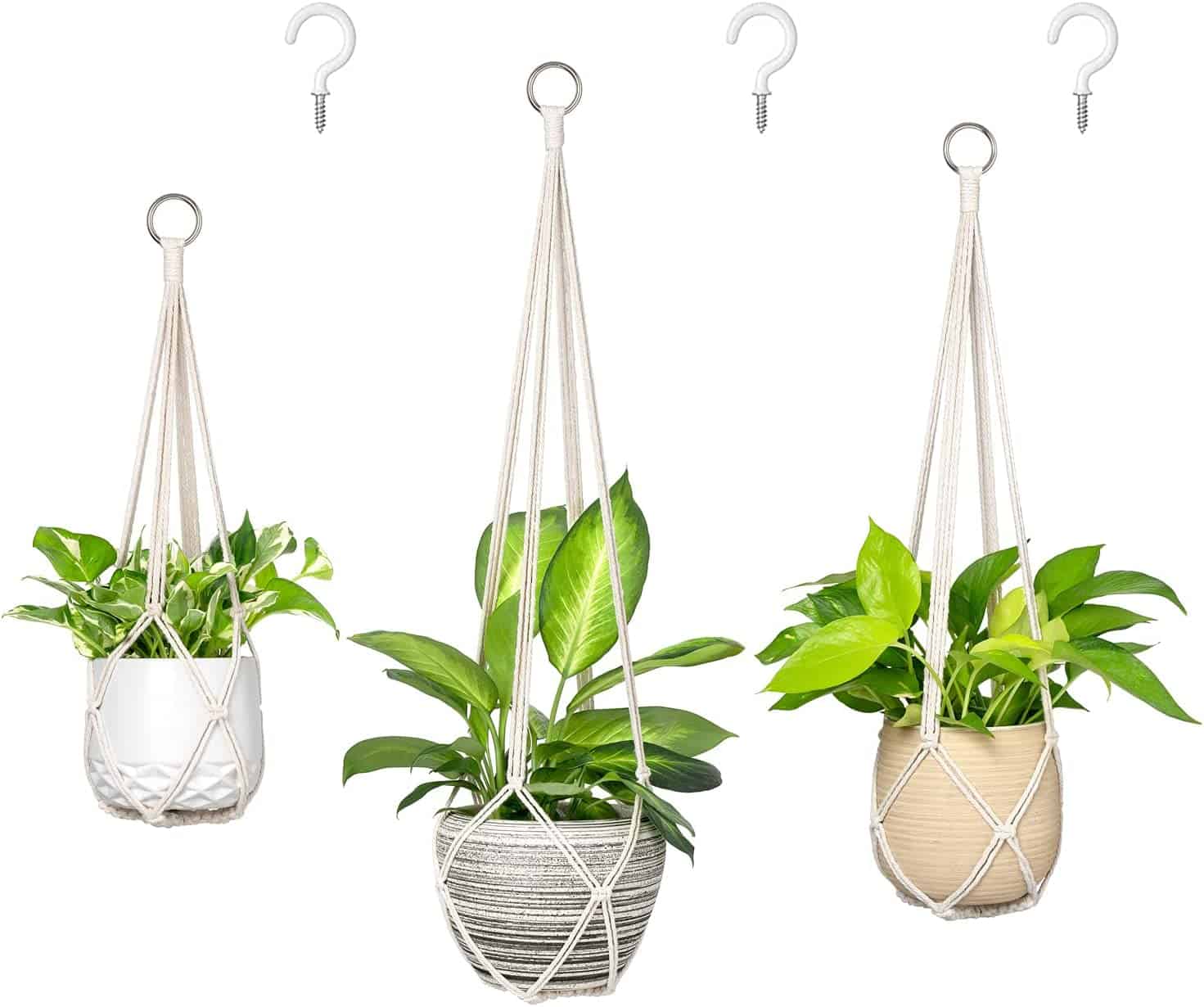If you’re looking to add some greenery to your home, hanging plants from the ceiling is a great way to do it. Not only does it add a touch of nature to your space, but it also frees up valuable floor space. However, if you’re not sure how to hang plants from the ceiling, it can be a bit daunting.
This post may contain affiliate links.
Fortunately, there are several ways to hang plants from the ceiling, and it’s easier than you might think. You can use hooks, brackets, or even macrame hangers to suspend your plants from the ceiling. The key is to choose the right method for your plant and your space. In this article, we’ll walk you through the different methods for hanging plants from the ceiling and provide tips for choosing the right one for your needs.

Related Article: 3 DIY Hanging Flower Pot Ideas
Understanding the Basics
Hanging plants from the ceiling can be a great way to add some greenery and aesthetic appeal to your indoor space. However, before you start, it’s important to understand the basics of hanging plants from the ceiling.
Choosing the Right Plant
It’s important that you choose the right plant for your hanging planter. Consider the weight of the plant and the weight capacity of the hook or hanger you plan to use. Lightweight plants like air plants and succulents are ideal for hanging from the ceiling, while heavier plants like orchids and philodendrons may require a sturdier hook or hanger.
Finding the Right Location
Next, you’ll need to find the right location for your hanging plant. Consider the amount of natural light the plant requires and the aesthetic you’re going for. South-facing windows are generally best for plants that require a lot of light, while shaded areas are better for plants that prefer indirect light.
Related Article: How to Fertilize Hanging Flower Baskets
Choosing the Right Hook or Hanger
When it comes to hanging plants from the ceiling, you have a few options for hooks and hangers. Swag hooks and plant hooks are popular choices, as they can be screwed into the ceiling and joist above for added safety. S-hooks and tension rods are also options for lightweight plants. Be sure to choose a hook or hanger that can support the weight of your plant.
6 Sets White Ceiling Hooks for Hanging Plant, Heavy Duty Swag Toggle Hooks with Hardware (White) 30 Pack S Hooks for Hanging 3.5 Inch | Heavy Duty Carbon Steel Hangers for Kitchen Utensils, Plants, Pot, Pan, Cups, Towels – Black
30 Pack S Hooks for Hanging 3.5 Inch | Heavy Duty Carbon Steel Hangers for Kitchen Utensils, Plants, Pot, Pan, Cups, Towels – Black
Installing the Hook or Hanger
Before you install the hook or hanger, it’s important to determine the location of the joist or stud in the ceiling. Use a stud finder to locate the joist or stud and mark the location with a pencil. If you’re hanging the plant from drywall, you’ll need to use a toggle anchor or toggle bolt to ensure the hook or hanger stays in place. Use a power drill and drill bit to create a pilot hole for the hook or hanger, then screw it in place.
Choosing the Right Container
Finally, you’ll need to choose the right container for your hanging plant. Consider the size and weight of the container, as well as the drainage needs of the plant. Terracotta and lightweight plastic containers are good options, as they won’t add too much weight to the hook or hanger. You can also opt for a macramé plant hanger or a hanging planter with built-in drainage.
Choosing the Right Location
When it comes to hanging plants from the ceiling, choosing the right location is crucial. Not only will it ensure that your plant gets the proper amount of light and humidity, but it will also add a touch of greenery to your indoor space.
Related Article: The Best Homemade Fertilizer for Flowering Plants
Consider Your Indoor Space
If you have a south-facing window in your living space, it might be the perfect spot for your hanging plant. South-facing windows receive the most sunlight throughout the day, which is ideal for plants that require a lot of light. However, if your apartment or living space doesn’t have a lot of floor space, hanging your plants from the ceiling is an excellent way to add some greenery without taking up valuable floor space.
Think About Humidity
Different plants require different levels of humidity. If you’re planning to hang your plant in a dry location, consider adding a humidifier to the room or misting the plant regularly to keep it healthy and happy.
Consider Your Patio
If you have a patio or outdoor space, hanging plants from the ceiling can add a touch of nature to your outdoor oasis. However, it’s essential to choose plants that can withstand the elements and ensure that they’re securely hung to prevent damage from wind and other weather conditions.
Choose the Right Spot
When choosing the right location for your hanging plant, make sure it’s in an area where you can easily access it for watering and maintenance. Hanging plants from the ceiling can be a beautiful addition to any indoor or outdoor space, but it’s crucial to choose the right spot to ensure they thrive.
Selecting Suitable Plants
When it comes to selecting plants to hang from your ceiling, it’s important to consider a few factors to ensure their success in this new environment. Here are some things to keep in mind:
Light Requirements
Different plants have different light requirements. Some plants thrive in bright, direct sunlight, while others prefer indirect or even low-light conditions. Before selecting a plant to hang from your ceiling, consider the amount of light the area receives throughout the day. If you have a bright, sunny spot, you may want to consider hanging a succulent, philodendron, or pothos. If your space is a bit darker, a jade, creeping fig, or English ivy may be a better choice.
Related Article: Gnat Spray for Indoor Plants
Watering Needs
Another important factor to consider when selecting a plant to hang from your ceiling is its watering needs. Some plants require frequent watering, while others prefer to dry out a bit between waterings. Air plants, for example, require only occasional misting, while orchids may require more frequent watering. Boston ferns, spider plants, and string of pearls are all relatively easy to care for and can tolerate a range of watering schedules.
Size and Weight
It’s also important to consider the size and weight of the plant you want to hang. Hanging plants can add a beautiful touch to any room, but you don’t want to risk damaging your ceiling or injuring anyone by hanging a plant that is too heavy. Nepenthes, for example, can be quite large and heavy, while air plants are much lighter and more compact. Before selecting a plant to hang, make sure you have a sturdy hook or support system in place.
Pick a Plant
With so many houseplants to choose from, it can be hard to pick just one to hang from your ceiling. Some popular options include spider plants, English ivy, and string of pearls. If you’re looking for a low-maintenance option, air plants are a great choice. For something a bit more exotic, consider a nepenthes or orchid. Ultimately, the choice is yours, and you should pick a plant that you love and that will thrive in your space.
Preparation and Safety Measures
Before hanging plants from your ceiling, it’s important to take some safety measures to ensure that you and your plants are safe. Here are some things you should consider:
Find the Studs
Use a stud finder to locate the joists or studs in your ceiling. This will help you find a secure spot to hang your plants from. Once you’ve found a stud, use a drill bit that’s slightly smaller than the screw you’ll be using to make a pilot hole. This will make it easier to screw in the hook and prevent the wood from splitting.
Related Article: 6 Natural Fertilizers for Indoor Plants
Weight Capacity
Make sure the hook you choose can support the weight of your plant and its pot. Check the weight capacity of the hook and compare it to the weight of your plant. If your plant is heavy, you may need to use a toggle bolt or toggle anchor to ensure that it’s securely fastened to the ceiling.
Use the Right Tools
Make sure you have the right tools for the job. A power drill, screws, pliers, and a hammer may all be necessary depending on the type of hook you’re using and the material of your ceiling. Always follow the manufacturer’s instructions for the hook and use the appropriate tools to avoid damaging your ceiling or the hook.
Drilling Holes
When drilling holes in your ceiling, make sure you’re drilling straight and perpendicular to the ceiling. This will ensure that the hook is securely fastened and won’t come loose over time. Additionally, be sure to clean up any debris or dust created by drilling to avoid creating a mess.
Installing the Hook
Hanging plants from the ceiling can be a great way to add some greenery to your home and make use of vertical space. But before you can hang your plants, you’ll need to install a hook in the ceiling. Here’s how to do it:
1. Choose the Right Hook
The first step is to choose the right hook for the job. There are a few different types of hooks you can use, including:
- Ceiling hooks: These hooks are designed specifically for hanging things from the ceiling. They come in a variety of designs and sizes, so choose one that will work for your plant and your ceiling.
- Swag hooks: Swag hooks are similar to ceiling hooks, but they’re designed to hold heavier objects. If you have a large plant or a heavy pot, a swag hook might be a better choice.
- Plant hooks: Plant hooks are designed specifically for hanging plants. They often have a curved design that helps support the weight of the plant.
2. Find the Right Spot
Once you have your hook, you’ll need to find the right spot to install it. Look for a spot in the ceiling that’s strong enough to support the weight of your plant. If you’re not sure, you can use a stud finder to locate a ceiling joist. If you can’t find a joist, you can use a toggle bolt to anchor the hook to the ceiling.
3. Install the Hook
To install the hook, follow these steps:
- If the hook you are using is a ceiling hook, simply screw it into the ceiling using a screwdriver or drill. If you’re using a swag hook or plant hook, you’ll need to install a toggle bolt first. To do this, drill a pilot hole in the ceiling, insert the toggle bolt, and tighten it until it’s secure.
- If you’re using a plastic toggle anchor, push it through the hole in the ceiling and then tighten the screw until the anchor expands and is secure.
- For an S-hook or other type of hook that doesn’t have a screw tip, you can simply hang it over the bolt or toggle.
- If the hook you are using has a screw tip, make sure it’s screwed in tightly so it can support the weight of your plant.
Related Article: Growing Hydrangeas in Pots
4. Hang Your Plant
Once your hook is installed, you can hang your plant using rope, chain, or another type of hanger. Make sure the hanger is strong enough to support the weight of your plant and adjust the length as needed to get the right height.
Macrame Plant Hanger Set of 3 with Hooks Indoor Hanging Planter Basket 35″/29″/23″ Handmade Woven Cotton Rope Flower Pot Crochet Plant Holder Stand for Boho Home Decor No Tassels,Beige Hanging Chain, 9.5 Inch, 4-Pack, White, for Bird Feeders, Planters, Fixtures, Lanterns, Suet Baskets, Wind Chimes and More! Outdoor/Indoor Use
Hanging Chain, 9.5 Inch, 4-Pack, White, for Bird Feeders, Planters, Fixtures, Lanterns, Suet Baskets, Wind Chimes and More! Outdoor/Indoor Use
Frequently Asked Questions
What are some alternatives to drilling holes in the ceiling to hang plants?
If you’re not comfortable drilling holes in your ceiling, there are a few alternatives you can try. One option is using adhesive hooks that are specifically designed for hanging plants. Another option is using a tension rod that fits snugly between two walls, allowing you to hang plants without any drilling.
What kind of ceiling hooks are best for hanging heavy plants?
For hanging heavy plants, it’s important to use a sturdy ceiling hook that can support the weight of the plant. Look for hooks that are made from strong materials like metal or heavy-duty plastic, and make sure they are rated for the weight of your plant.
Can adhesive ceiling hooks hold up hanging plants?
Adhesive ceiling hooks can be a great option for hanging lightweight plants, but they may not be strong enough to support heavier plants. Make sure to choose adhesive hooks that are rated for the weight of your plant, and consider using multiple hooks for added support.
What materials do I need to hang plants from the ceiling?
To hang plants from the ceiling, you’ll need a few basic materials, including a ceiling hook or other hanging mechanism, a sturdy plant hanger or basket, and a plant that is suitable for hanging. You may also need a drill and screws if you’re planning to install a ceiling hook.
How do I find the studs in my plaster ceiling to hang plants?
Finding studs in a plaster ceiling can be a bit tricky, but there are a few methods you can try. One option is using a stud finder, which can detect the location of studs behind the plaster. Another option is tapping on the ceiling with a hammer or other tool to listen for a solid sound, which can indicate the presence of a stud.
Are there any creative ways to hang plants in front of windows without obstructing the view?
If you want to hang plants in front of a window without blocking the view, there are a few creative options you can try. One option is using a tension rod to hang plants in the window frame or using suction cups to attach plants directly to the window glass. You can also try hanging plants from the ceiling in front of the window, using clear fishing line or other transparent materials to minimize the visual impact.
Follow my gardening board on Pinterest.






